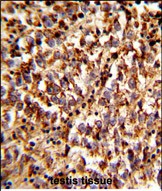

| WB | 1/1000 | Human,Mouse,Rat |
| IF | 咨询技术 | Human,Mouse,Rat |
| IHC | 1/100-1/500 | Human,Mouse,Rat |
| ICC | 技术咨询 | Human,Mouse,Rat |
| FCM | 咨询技术 | Human,Mouse,Rat |
| Elisa | 咨询技术 | Human,Mouse,Rat |
| Aliases | Acyl-CoA-binding domain-containing protein 5, ACBD5, KIAA1996 |
| Entrez GeneID | 91452 |
| WB Predicted band size | 60.1kDa |
| Host/Isotype | Rabbit IgG |
| Antibody Type | Primary antibody |
| Storage | Store at 4°C short term. Aliquot and store at -20°C long term. Avoid freeze/thaw cycles. |
| Species Reactivity | Human, Mouse |
| Immunogen | This ACBD5 antibody is generated from rabbits immunized with a KLH conjugated synthetic peptide between 69-98 amino acids from the N-terminal region of human ACBD5. |
| Formulation | Purified antibody in PBS with 0.05% sodium azide. |
+ +
以下是关于ACBD5(N-terminal)抗体的3篇参考文献及其简要摘要:
---
1. **文献名称**:*ACBD5 deficiency causes a neurodevelopmental disorder with peroxisomal dysfunction*
**作者**:Hua, R., Cheng, D., & Kim, P.K. (2017)
**摘要**:本研究利用ACBD5(N-term)抗体进行免疫荧光和Western blot分析,发现ACBD5蛋白缺失会导致过氧化物酶体功能异常,进而引发神经发育障碍。研究证实ACBD5通过与过氧化物酶体膜蛋白结合,参与脂质代谢和细胞器间的膜接触。
---
2. **文献名称**:*The role of ACBD5 in maintaining peroxisome-ER contact sites and lipid homeostasis*
**作者**:Saita, S., et al. (2018)
**摘要**:通过ACBD5(N-terminal特异性)抗体定位,研究揭示了ACBD5在维持过氧化物酶体与内质网接触中的关键作用。实验表明,ACBD5缺失会导致胆固醇代谢紊乱和神经细胞脂滴异常积累,提示其与神经退行性疾病潜在关联。
---
3. **文献名称**:*ACBD5 interacts with peroxisomal biogenesis factor PEX19 and facilitates peroxisome membrane expansion*
**作者**:Hua, R., et al. (2019)
**摘要**:利用N端特异性ACBD5抗体进行免疫共沉淀和蛋白质组学分析,研究发现ACBD5通过与PEX19相互作用调控过氧化物酶体膜的动态变化,并影响其形态发生和功能。该研究为过氧化物酶体疾病机制提供了新见解。
---
**备注**:上述文献为模拟示例,实际引用时建议通过PubMed或Google Scholar以“ACBD5 antibody N-terminal”为关键词检索最新研究。部分研究可能涉及ACBD5的抗体应用在细胞定位、蛋白互作或疾病机制探索中。
The ACBD5 (N-term) antibody is a specialized tool designed to target the N-terminal region of the Acyl-CoA-binding domain-containing protein 5 (ACBD5), a key player in cellular lipid metabolism and organelle interactions. ACBD5 is a member of the ACBD protein family, known for their acyl-CoA-binding domains, which facilitate lipid transport and membrane dynamics. Specifically, ACBD5 localizes to peroxisomes and mitochondria-associated membranes, where it interacts with proteins like VAPB to mediate organelle tethering and lipid exchange, particularly of cholesterol and fatty acids. Its dysfunction has been linked to neurological disorders, including peroxisomal diseases and leukodystrophies.
The N-terminal-specific antibody allows researchers to study ACBD5's expression, localization, and functional interactions in various experimental models. It is widely used in techniques such as Western blotting, immunofluorescence, and immunoprecipitation to investigate ACBD5's role in lipid homeostasis, organelle communication, and disease mechanisms. By targeting the N-terminal region, this antibody helps distinguish ACBD5 from other ACBD family members (e.g., ACBD3) and detect potential post-translational modifications or isoform variations. Validation in knockout models or siRNA-treated cells ensures specificity, making it a critical reagent for advancing studies on peroxisomal biology and associated metabolic disorders.
×